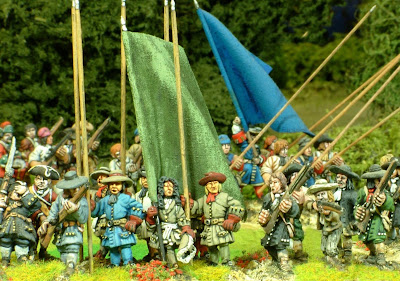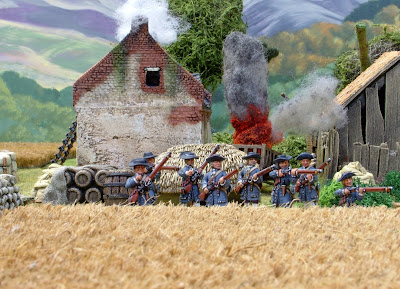 |
| Marlborough's interesting and challenging Command |
Now then, saving the most interesting till last? What to do with Mr Churchill? I had cast him in the role of undecided. He had played little part in the alternative history between 1690 and our current point the summer of 1692.
He appeared to have retired to country life, taking time to be with his family, explore alternative sources of income to soldiering and general putting himself in a financially stable position without the patronage of either King.... and that is just what the crafty bugger got on with particularly during June, July and August of 1692.
 |
| Many of his officers wore civilian clothes and no field signs as a deliberate instruction |
Several players made approaches to Churchill via that well known 17th century channel of communication, email. His answers varied between brusque and business like to obsequious, contingent on the sender. He returned gifts of trinkets and money with a haughty and indignant air suggestive of one insulted by those who wanted to by him off cheaply. Yet purred like a cat to seemingly empty promises of future wealth and power.
 |
| Most of the men were civilian estate workers wearing their own clothes in the field |
At the very same time his agents were robbing properties and wagon trains (often belonging to those men whose gifts were being so disdainfully rejected), setting alight to forage and ammunition depots, stealing cattle and horses, extorting money with menaces, stockpiling weapons and generally setting up such an atmosphere of febrile distrust that no one, even those on the same side knew exactly who to trust. The counties of Warwickshire, Staffordshire, Leicestershire, Gloucestershire, Buckinghamshire and Berkshire were all subjected to the attentions of seemingly unaligned gangs roaming and plundering, acquiring and collecting whilst declaring for none and wearing no visible field sign or token of allegiance.
Churchill actively (but secretly) encouraged the mutiny of the Coldstream Guards at Warwick and subsequently offered the deserters some land in Wytham Woods near Oxford in which to set up camp. He provisioned them and courted their officers with dinner and wine. All this to assist now penniless comrades in arms many of whom he had served with in previous campaigns.
 |
| Skirmishing with both armies preoccupied Marlborough's County Defence force |
He scoured the countryside for men to join 'civil defence' companies and had these drilled and captained by army officers who had found themselves in the vicinity of the university city. He acted as a beacon of reason, a symbol of simple hope, the spirit of England. The population of Oxfordshire adored him as a benevolent Father and protector of their goods an chattels. Meanwhile............
More about his escapades will emerge as the series continues but for now we can review his militarily weak but numerous and well supplied forces.
 |
| Both armies raided and foraged incessantly during June to August 1692 |
Lieutenant General John Churchill's Command
The County Defence forces of Oxfordshire raised by Churchill created a permeable exclusion zone within the county which acted as a form of breakwater and buffer for the armies of King James and King William. The troops had limited combat capability but did score some notable successes against 'hostiles' on occasion.
Charles Churchill's Brigade
General Churchill's Regiment of Horse: A cavalry regiment of 12 models recruited from army deserters and ex soldiers. Classed as Bullet Horse. Graded as Drilled and given the suffix Elite.
Colonel Churchill's Regiment of Horse: A cavalry regiment of 12 models recruited from army deserters and ex soldiers. Classed as Bullet Horse. Graded as Drilled.
 |
| The Earl used his charm on local populations in order to keep them on side. |
Lord Randolph's Brigade
Colonel Randolph's Volunteer Regiment of Horse: A cavalry regiment of 12 models. Mostly estate workers from around the county. Classed as Bullet Horse. Graded as Raw.
The Hon. Henry Jervais' Regiment of Horse: A cavalry regiment of 6 models recruited from gentlemen at arms and equipped as cuirassiers. Classed as Bullet Horse. Graded as Raw and given the suffix Elite.
Sir Oliver deHavilland's Brigade
Colonel Lindsay's Shire Volunteer Regiment of Horse: A cavalry regiment of 12 models. Mostly estate workers from around the county. Classed as Bullet Horse. Graded as Raw.
Oxford City Volunteer Cavalry: A cavalry regiment of 12 models recruited from the tradesmen and merchants of Oxford. Classed as Bullet Horse. Graded as Raw.
 |
| Many veterans of the campaigns in Tangier joined the Earl's regiments |
Sir George Osbourne's Brigade
The Earl of Marlborough's Regiment: A regiment of 18 models. Formed as Regulation ie the normal proportion of pike to shot. The men are estate workers and volunteers. Graded as Raw.
Captain Sandy's Volunteers: An regiment of 12 models formed from army deserters, mercenaries and volunteers. Formed as All musket ie carrying no pikes. Graded as Drilled.
Colonel Jedidiah Smollett's Regiment: A regiment of 18 models. The men are volunteers from the Oxford Trades Association. Formed as Pike & Shot ie carrying a higher proportion of pikes than normal. Graded as Raw.
 |
| The Wytham Volunteers.. aka The Coldstream Guards (they tore off the RWMR cypher from their colours) |
Independent Command
The Wytham Volunteers: A regiment of 9 models formed from deserters of the Coldstream Guards and displaced army officers camping at the Earl's pleasure in Wytham Woods near Oxford. Classed as All musket. Graded as Drilled.
